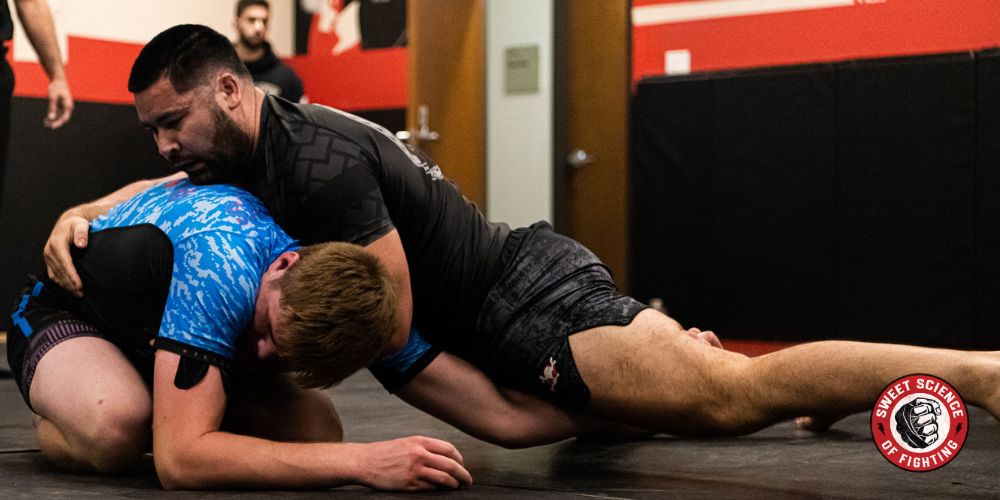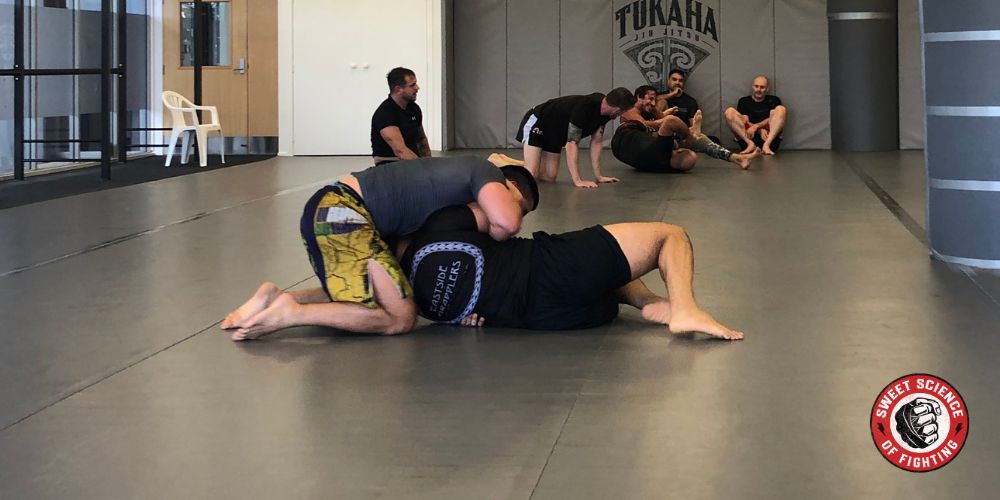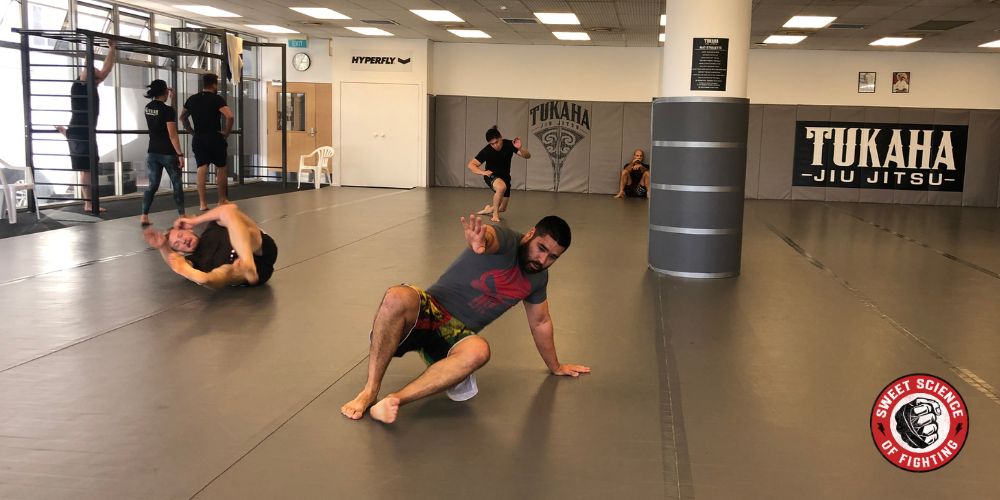Terms in grappling sports can be confusing for someone without experience in the field. Brazilian jiu-jitsu, no-gi, submission grappling, submission wrestling, and catch wrestling are just some of the few subsets of grappling you can run into. But do you know what the differences are?
The main difference between Brazilian jiu-jitsu and submission wrestling is that BJJ is done in a gi, which determines the dynamics and tactics of a match. Submission wrestling doesn’t use a gi, and clothing cannot be manipulated, meaning matches are faster and more dynamic. In addition, different grappling styles like sambo and judo are used in submission grappling, including BJJ.
This answer does not exhaust the question, and there are many more details even before we start comparing no-gi BJJ and submission wrestling. Some differences are more subtle, others more obvious, but all of them are good to know if you train or love watching grappling competitions in all forms.
What Is The Difference Between BJJ and Submission Wrestling
Submission wrestling and submission grappling are used interchangeably and thrown around as a substitute for no-gi BJJ, but this is not entirely correct. While submission wrestling and no-gi BJJ are very similar, there are still slight differences.
A lot more differentiates the three subsets of grappling, and I will do my best to detail every aspect that makes BJJ, no-gi BJJ, and submission grappling distinct.
Clothing
The clothing is the first and most apparent difference between BJJ and submission wrestling. Brazilian Jiu-Jitsu practitioners train and compete in a traditional gi consisting of a heavy cotton jacket, trousers, and a colored belt denoting rank.
In submission wrestling and no-gi BJJ, athletes wear rash guards and BJJ shorts and can even compete topless under some rulesets.
The clothing makes a huge difference in the style because the gi can be grabbed and manipulated, while in submission wrestling, you are not allowed to do that. This creates some drastic differences, which I will outline in the following paragraphs.
Tournaments

The IBJJF is the largest BJJ organization on the planet, and it hosts numerous tournaments at all levels in many countries. Most domestic organizations are branches of the IBJJF.
In general, the overwhelming majority of GI tournaments are held under the supervision of the IBJJF, and even when this is not the case, the rules used are directly taken from them. The IBJJF also hosts no-gi BJJ tournaments.
5 Step Blueprint To Build A BJJ Strength Workout To Demolish Your Opposition
Learn how to plan your strength training to maximize transfer to the mats.
On the other hand, submission grappling is not as uniform, and there are many different organizations and varying rulesets.
But the most prestigious one is the ADCC, considered the Olympics of grappling. The final tournament is held every two years and gathers the best grapplers from all styles.
Styles
Brazilian jiu-jitsu is a part of submission wrestling. While BJJ athletes often dominate submission grappling tournaments, other styles like Judo, catch wrestling, sambo, wrestling, and others are at home in submission grappling, as is BJJ.
Most ADCC winners have been BJJ practitioners, but some notable champions are coming from other styles, like wrestlers Mark Kerr, Jeff Monson, Kareem Barlaev, judoka Kikuta Sanae, and many others who have not won gold medals but did very well in tournaments.
Less Friction Means More Speed
When you remove the gi and its sweat-soaking capabilities, grapplers quickly become sweaty and slippery. This makes gripping the opponent and applying submissions much more difficult. Removing the gi removes all the sleeve and lapel grips used in BJJ to slow down the action, making submission grappling much faster.
Static positions are hard to hold, and scrambles become common. Each position requires more effort to hold, just like each submission to lock, resulting in faster and more dynamic matches.
Another way the gi slows things down in competition is through its readjustment. Under the IBJJF rules, competitors are allowed up to 20 seconds to re-adjust the gi, which can amount to minutes of rest in more extreme cases. In submission grappling, there are no rests during the round.
The higher pace and intensity generally make submission wrestling more exciting for the audience.
Types of Submissions

It’s no coincidence many of the submissions in BJJ tournaments are chokes. The gi opens up the possibilities for a myriad of chokes, like the bow and arrow choke, the Ezekiel choke, baseball bat chokes, and many others.
The gi not only opens up new chokes but also gets in the way of others, like the anaconda and Darce choke, making them more difficult to finish.
On the other hand, heel hooks and other leg-locking moves are banned for most or all belt ranks but are fair game in submission grappling, changing the way the game is played and the types of submissions used.
In fact, leg locks have become a central part of submission wrestling in the past few years but are still banned in gi tournaments.
Neck cranks are also part of submission grappling, mainly coming from catch wrestling, while in BJJ, they are not as common.
Rules And Scoring
The rules in BJJ and submission grappling are also different. The first point of difference is the scoring. Some submission grappling organizations have submission-only matches, meaning no points are awarded, and you can win only by tapping the opponent.
Such a ruleset is the Eddie Bravo Invitational, although if the match reaches the time limit, there is a system to determine the winner even without a submission.
But if we compare the two main rulesets, the IBJJF and ADCC, both have clear scoring, allowing you to win a match on points. Points are scored for obtaining a position, controlling the opponent, and doing transitions.
Here is a brief overview of the IBJJF scoring system:
- Takedown: 2 points
- Sweep: 2 points
- Guard pass: 3 points
- Knee-on-belly: 2 points
- Mount: 4 points
- Back mount/back control: 4 points
And how ADCC matches are scored:
- Takedown: 2 points if you land in the bottom person’s guard /4 points If you land past the bottom person’s guard.
- Sweep: 2 points if you land in the bottom person’s guard /4 points If you land past the bottom person’s guard.
- Knee-on-belly position: 2 points
- Guard passing: 3 points
- Mount: 2 points
- Back mount/back control: 3 points
A key difference between the ADCC and IBJJF rules is the ADCC does not award any points during the first half of the match. For example, in a 10-minute qualifying round match, for the first 5 minutes, you can’t win positive points, and the same goes for the first 10 minutes of a 20-minute finals match.
Gi tournaments also score advantages that aim to resolve tiebreakers. Advantages are awarded when you almost complete a submission or achieve a position, but they are often unfair and do not exist in submission wrestling.
Another key difference in the rules is the banned techniques. Under IBJJF rules, each belt rank has several restrictions on specific moves, and even brown and black belts have a lot of things they are not allowed to use, like heel hooks and neck cranks.
On the other hand, the ADCC has a lot more liberal rules, and there are far fewer restrictions and ways to get disqualified.
Training
Because of the faster pace and intensity of matches, submission wrestlers need better strength and conditioning than their gi counterparts.
This does not say BJJ guys are weaker or less conditioned, but in the gi, you have other tools at your disposal, while in no-gi, physical attributes play a more significant role. This changes the preparation and training for the two sub-styles.
Are No-Gi and Submission Wrestling The Same?

Despite the considerable overlap, there are some differences between no-gi BJJ and submission wrestling. The scoring and banned techniques are the only difference between no-gi IBJJF rules and submission grappling organizations like the ADCC.
Under the ADCC, takedowns are more important, and slams are allowed to get out of submission, which is not the case in no-gi BJJ. ADCC also does not encourage guard pulling, which makes a big difference in game plans.
Competitors’ approaches may also be quite different because of the many styles found in submission wrestling. For instance, In BJJ, positioning and clean submissions are the norm, while catch wrestling is much more intense, fast-paced, and intent on causing pain.
So, the approach and tactics in submission wrestling can be more varied than in no-gi, and in the past, the distinction between BJJ guys competing in no-gi like Andre Galvao and Keenan Cornelius and catch wrestlers like Josh Barnett was more easily distinguished.
But younger competitors have become more well-rounded, and the differences have diminished.
Technically, no-gi and submission grappling are two different things, but they are almost the same. The only significant differences are between gi grappling and no-gi grappling; everything else is minor rule tweaks.
Summary
Technically speaking, BJJ is a form of submission wrestling. But the term submission grappling means no-gi grappling, popularized mainly by the ADCC, and different styles like judo, sambo, and catch wrestling are also used there.
Brazilian jiu-jitsu, on the other hand, is done with a gi, which increases the friction between the grapplers, allows for gi chokes, and slows down the action because of the many grips available. The rest of the differences are minor and depend on the rules of each specific organization.

